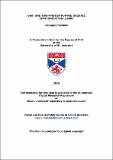Files in this item
One- and two-photon pumped organic semiconductor lasers
Item metadata
| dc.contributor.advisor | Turnbull, Graham A. | |
| dc.contributor.advisor | Samuel, Ifor D. W. | |
| dc.contributor.author | Tsiminis, Georgios | |
| dc.coverage.spatial | 184 | en_US |
| dc.date.accessioned | 2010-06-22T09:08:30Z | |
| dc.date.available | 2010-06-22T09:08:30Z | |
| dc.date.issued | 2010 | |
| dc.identifier | uk.bl.ethos.552390 | |
| dc.identifier.uri | https://hdl.handle.net/10023/927 | |
| dc.description.abstract | This thesis describes a number of studies on organic semiconductors focused around using them as gain media for lasers. The photophysical properties of organic semiconductors are studied using a wide range of experimental techniques, allowing the evaluation of new materials and novel excitation schemes for use in organic semiconductor lasers. Polyfluorene is a well-established conjugated polymer laser gain medium and in this thesis its excellent lasing properties are combined with its two photon absorption properties to demonstrate a tunable two-photon pumped solid-state laser based on a commercially available organic semiconductor. A family of bisfluorene dendrimers was studied using a number of photophysical techniques to evaluate their potential as laser materials. Distributed feedback lasers based on one of the dendrimers are demonstrated with lasing thresholds comparable to polyfluorene. The same materials were found to have enhanced two-photon absorption properties in comparison to polyfluorene, leading to the fabrication of tunable two-photon pumped dendrimer lasers. A member of a novel family of star-shaped oligofluorene truxenes was evaluated as a laser gain material and the distributed feedback lasers made from them show some of the lowest lasing thresholds reported for organic semiconductors, partly as a consequence of exceptionally low waveguide losses in comparison to other single-material thin films. Finally, an organic laser dye is blended with a conjugated polymer, where the dye molecules harvest the excitation light of a GaN laser diode and transfer its energy to the polymer molecules. This is the first time such a scheme is used in an organic laser and in combination with a novel surface-emitting distributed Bragg reflector resonator allows the demonstration of a diode-pumped organic laser, a significant step towards simplifying organic lasers. | en_US |
| dc.language.iso | en | en_US |
| dc.publisher | University of St Andrews | |
| dc.subject | Laser | en_US |
| dc.subject | Organic semiconductor | en_US |
| dc.subject | Nonlinear optics | en_US |
| dc.subject | Polymer | en_US |
| dc.subject | Photonics | en_US |
| dc.subject | Device | en_US |
| dc.subject | Organic | en_US |
| dc.subject | Materials | en_US |
| dc.subject.lcc | TA1700.T8 | |
| dc.subject.lcsh | Semiconductor lasers--Materials | en_US |
| dc.subject.lcsh | Organic semiconductors | en_US |
| dc.subject.lcsh | Optical pumping | en_US |
| dc.subject.lcsh | Tunable lasers | en_US |
| dc.title | One- and two-photon pumped organic semiconductor lasers | en_US |
| dc.type | Thesis | en_US |
| dc.type.qualificationlevel | Doctoral | en_US |
| dc.type.qualificationname | PhD Doctor of Philosophy | en_US |
| dc.publisher.institution | The University of St Andrews | en_US |
This item appears in the following Collection(s)
Items in the St Andrews Research Repository are protected by copyright, with all rights reserved, unless otherwise indicated.

